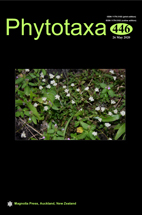Abstract
Pseudodactylaria fusiformis sp. nov. was collected during an investigation of freshwater fungi along a north-south latitudinal gradient in the Asian region. Evidence for the new species is provided by morphological comparison and sequence data analysis. Pseudodactylaria fusiformis differs from other species in having hyaline conidiophores and fusiform, 0–1-septate hyaline conidia without a sheath. Phylogenetic analysis based on combined ITS and LSU sequence data was carried out to determine the phylogenetic placement of the species. Six Pseudodactylaria taxa clustered together and formed a monotypic clade representing the genus, and five species are well recognized. Pseudodactylaria fusiformis and P. camporesiana share a sister relationship and they are phylogenetically distinct species. A detailed description and illustration are provided, as well as the comparisons with similar taxa.

